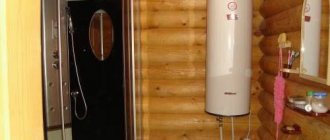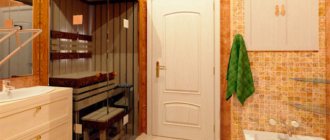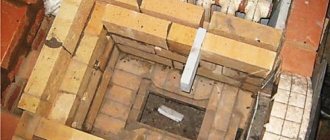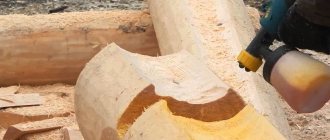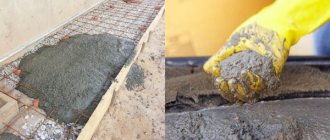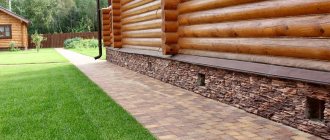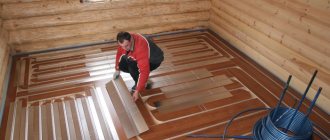Before you begin installing a sewer system in your dacha, you need to decide what exactly the drainage and filtration scheme will be. There are several technical points that should be present in every system:
- The distance from the receiving well to the water wells must be in accordance with SNiP.
- The diameter of the pipeline through which sewage will be drained must correspond to the number of plumbing fixtures and the approximate efficiency.
- The depth of the external trench cannot be higher than the soil freezing layer.
- It is necessary to have a sealed well or septic tank for drainage.
Types of devices for a country house
- Filtration septic tank with a compartment for settling the thick fraction. This is an advanced technology, the main operating principle of which is to separate sewage that enters the collector and divide it into fractions. As a result of passing through several filtration chambers, the liquid is purified to a state that is safe from the point of view of sanitary standards.
- Local treatment plant. In fact, these are mini-purification plants based on the use of bacteria to purify water.
- Using the container as a cesspool.
Country drainage can be separate and common
The first case is when wastewater from different plumbing fixtures enters different containers for sedimentation and filtration. In addition, separate delivery of water from street storm water collectors and the internal network is considered a separate form.
The general sewage collection and drainage system consists of laying a single pipeline both for indoor appliances and for collecting water outside.
Briefly about the main thing
Before draining water at your dacha with your own hands, you need to decide which method of waste disposal is optimal in your case. The easiest way is to dig a cesspool or install a storage tank, but these options are not the best, especially if the dacha is used all year round by a family of more than 2-3 people. Multi-chamber septic tanks with natural or biochemical treatment are much more reliable and convenient. They will require more investments, but they will serve for a long time and reliably under one condition: if all calculations are made correctly, and the system is installed with high quality and in compliance with all requirements.
Source
Year-round accommodation and summer
If no one lives at the dacha in winter, then it is enough to assemble a summer sewage system. In this case, there is no need to dig a deep trench and lay a larger diameter pipeline.
The outlet from the house also does not need to be installed at the very bottom of the foundation. The exit is made directly from the top point of the plumbing fixture. A simple scheme for collecting summer sewage in the photo:
As for the collector into which the water will be drained, it must still be sealed and securely installed. There is no need to install a septic tank; a regular drainage pit will do just fine. At the end of the summer season, it will simply have to be pumped out and preserved for the winter.
If you live year-round in a private house, you will have to complicate the task a little. To use water and a toilet in cold weather, it is necessary to ensure good insulation of external sewer pipes. In addition, there are still some difficulties during installation. This includes the depth to which the external sections of the water supply system are buried, its insulation, and many other factors.
Is it legal to drain into a drainage ditch?
Flow stations or VOCs from leading manufacturers clean wastewater efficiently, so there will be no problems with the law when discharging into a ditch. Especially when using ultraviolet disinfection and a microfilter at the exit from the aeration station.
Expert opinion
Albert Lyushin
Engineer-technologist with more than 15 years of experience.
Order installation of a septic tank
There are some nuances with septic tanks made of concrete rings:
- firstly, through the seams of concrete rings, even if they are sealed, sooner or later its contents leak out and clog the soil;
- secondly, this design does not clean the wastewater in any way.
According to the law, this will be equivalent to waste dumping. In this case, administrative punishment is provided.
You can view the standards for the installation of autonomous sewage systems in the regulatory document SP 30.13330.2016 (Current edition of SNiP 2.04.01-85).
Where to complain if neighbors drain wastewater into a ditch, storm drain or onto the terrain
Neighbors should know that the federal law on sanitary and epidemiological welfare provides for administrative liability for such discharge of wastewater without prior disinfection. You can write a complaint to SNT Rospotrebnadzor, and then go to court with their written response. In practice, such cases occur extremely rarely.
Where to drain purified water if there is no ditch
Wastewater treated with a septic tank must be supplied for post-treatment in filtration fields or in a drainage well. But not everyone has the space to install them on their summer cottage. In this case, all that remains is to use the drive.
Is it possible to drain water into your garden for irrigation?
It is undesirable to water vegetable gardens even with clarified wastewater from a biological station. After energy-independent anaerobic septic tanks, water is not suitable not only for irrigation, but also for discharge onto the ground.
Get a response within 3-12 hours from a specialist
Norms for the distance of treatment facilities on the site
According to SNiP, treatment facilities and pits must be located at a considerable distance from the house, water well and other engineering facilities.
- From a residential building - at least 5 m to a septic tank, VOC, cesspool to avoid unpleasant odors entering the room. And also prevent in advance the possible disastrous consequences of the influence of a humid environment on the foundation of the house.
- It is 30-50 m to a water well. Of course, it is very difficult to follow this rule, since the size of the plots is very limited. It is still necessary to remove the septic tank from the water supply system as much as possible, to the extent technically possible.
- To the borders of the neighboring plot - at least 2 m.
- From the collector to plants and trees - the location is 2-4 m if the tree roots are large.
Rules for choosing the volume and location of septic tanks
The daily water consumption rate is 200 liters per person, and the septic tank must be able to accommodate wastewater. Collected within 72 hours or 3 days. Thus, subject to permanent residence, a three-chamber septic tank made of 250-liter barrels is suitable only for one person. Therefore, septic tanks of this type are used only for temporary residence or for treating wastewater from one point (for example, from a bathhouse). In most cases, they try to somehow increase the capacity of septic tanks, which is why among treatment facilities made from barrels there are practically no two-chamber options (they have too small a volume).
It is important to comply with sanitary requirements regarding permissible distances from the septic tank to certain objects. For example, the distance from the source of drinking water should be at least 50 meters. Garden plants and fruit trees must be located at least 3 meters from the treatment plant
Distance to the road – at least 5 meters
Garden plants and fruit trees must be located at least 3 meters from the treatment plant. The distance to the road is at least 5 meters.
Conditions of a homemade pump for overflowing water...
To get started, I suggest you watch a video about this homemade product:
Probably many people have ever had the problem of pouring water from one vessel to another... Of course, you can simply lift and turn one vessel over another, but... this method is not always good, since the vessel can be large, that is, you will have a lot of weight containers and you simply cannot physically lift the container...
The second way is to pour, for example, in mugs... But this method is also not always good, since, for example, the shape of the vessel may not allow you to scoop up water in mugs or some other circumstances... And then the old proven method of pouring liquid comes to mind - take a flexible hose, lower one end of the hose into a container of water, and take the other end of the hose into the oral cavity and sharply blow air into yourself... Pressure will be created and then water will pour out of one container into another by inertia until you pull out the hose... Simple physics , but... this method is not very hygienic, and if the circumstances are bad, you can even choke on water... Therefore, this method is quite dangerous...
So, let's begin…
In order to make a pump we will need: - a bottle cap; - a drill and an 8 mm drill bit; - scissors or a knife; - a threaded bottle “neck”; - a flexible hose; - a small piece of pipe...
To begin, remove the gasket from under the lid and cut off its edges as shown in the photo, leaving a small “tail”...
Now we carefully place the cut gasket inside the lid and tighten it as shown in the photo... Our cut gasket will serve us as a valve...
We cut off the “neck” from another bottle and do something like a turbo water intake...
Now we put on a flexible hose from the other end of the pipe...
That's all!!! Our water overflow pump is ready...
Now we lower the side of the pipe where the valve is located into a container with water, and with sharp up and down movements we build up pressure... Water flows through the valve into the pipe and then into the hose, and from there it pours out...
Materials and tools
- To dig a trench, you will need a small excavator. If there is no possibility of heavy equipment coming in, you will have to take up shovels.
- The pipes need to be cut with something, some people use a grinder with adjustable speed, or you can use a hacksaw with fine teeth.
- Jackhammer, perforator - make holes in the well and foundation of the house.
- Sand or fine ASG for fixing the pipeline in the trench.
- Insulation, thermal insulation in places where laying sewerage through an external network to a depth below the soil freezing layer is impossible.
The main segment of the drainage system is the pipe, here are its main options:
- Red PVC is available in various sizes.
- Black polyethylene ones also come in diameters from 50 to 159 mm.
- Ribbed - pragma. The length is 4 and 6 m, the diameter is from 100 mm to 500 mm.
- Gray polypropylene (plastic).
Preservation of the well for the winter
Preservation of a well that will not be used in winter begins before the onset of frost. It is convenient to carry out operations if the check valve is installed in an accessible place immediately after the pump. Some models of submersible pumps are equipped with a built-in valve.
Conservation of the summer version of the well is carried out in the following sequence:
- Turn off the power supply.
- Open the water tap.
- Expect a drop in pressure in the system. When it reaches 0.5 atm, the automatic valve opens. It is mounted below the soil freezing level on the supply hose.
- Unscrew and remove the control unit.
If the well is equipped with an adapter, the hydraulic tank with automation is located in the house. The pipes are located below the freezing point.
To mothball the well, the pump is disconnected from the electricity and the water tap in the house is opened. When the pressure in the system drops, the valve is activated. Water from the pipeline leading into the house is drained into a well.
If the well is equipped with a caisson, the pumped storage tank and automation are located mainly in it.
Preservation is carried out in several stages:
- Electricity is cut off from the pump. Open the shut-off valve on the pipeline to the house.
- They are lowered into the caisson. Open all the taps, except the one on the riser to connect the watering of the area.
- They wait for the water to drain into the well. Open the watering tap and drain the remaining liquid.
It is not necessary to lift the pump from the well. The temperature in it is above zero, the water does not freeze. Equipment is removed and stored when thieves are feared.
Do-it-yourself system installation in a private house
After the cesspool is placed on the site, you can begin to dig a trench to the required depth. In the central part of Russia it is 2-2.5 meters, in the northern regions it is a meter more, and in the southern regions it is 1-1.5 meters. They begin to dig a trench from the wastewater intake point to the top, towards the house.
Now a fine sand and gravel mixture, a “cushion,” is poured onto the bottom of the pit along its entire length. It’s better to immediately “shoot” the slope at least a little and level the sand.
The next step will be laying the pipeline itself. First, the end is inserted into the well so that the socket faces towards the house. It is advisable to immediately secure the pipe in the hole with mortar or foam. Then they are connected in series with the blank end into a socket. To simplify the process, the rubber bands are lubricated with motor oil or special lubricant.
Each pipe is measured to ensure it meets the required slope. This can be done with a building level, but it is better to take a level.
According to SNiP, sewerage is laid along a slope corresponding to the diameter of the pipe. For a diameter of 40-50 mm, the roll is 3 cm per meter, 85-100 mm - 2 cm per 1 m, and for 150 mm it will be 0.8 cm per 1 m.
After assembling the outer line, the line is aligned along its entire length so that the entire straight section is visible through the hole.
Local sewerage system with wastewater treatment
For a cottage equipped with modern plumbing equipment - a bathtub, toilet and bidet - a bunker-type sewer storage tank will not be enough.
A wastewater treatment complex will allow minimizing calls to specialists with treatment equipment, completely covering the need for sewerage, and avoiding local problems with soil contamination with sewage.
The principle of clarification (purification) of household wastewater through a system of drainage pipes is based on the natural order of filtration of fecal waste, which “works” in nature. Through the riser in the house, wastewater flows into a pipeline connecting the cottage and the septic tank. Sufficient volume of the sewer well is 2.5 m3.
When planning the landscape of a suburban area, we must not forget about the need to clean the septic tank. The car may not pass, and its hoses are not long enough
In such a storage tank, household wastewater is clarified with the precipitation of suspended matter. You will need to hire a sludge sucker with a team to clean the sludge deposited in the septic tank twice a year.
Self-cleaning with neutralization of sediments in a specially designed compost bin is also acceptable (see below). Clarified sewage water is sent to the drainage network, from where it goes into the ground.
The drainage pit is located at a distance of 5-20 m from the house. The main requirement for the location and positioning of the drainage network is a sufficient distance from the building so that the wastewater entering the ground does not wash away the foundation or flood the cellar.
From the sewer settling tank, the clarified waste stream moves first into a distribution well, then from it into a system of perforated drainage pipes made of polymer or asbestos cement.
Drainage pipes are laid at a depth of at least half a meter, actually at the level of development of the soil-vegetative layer. If the soil developed on sandy soil, then the length of the drains is calculated taking into account 10 m per person.
In soil with a sandy loam base, the length of the perforated pipe should reach 14 - 17 m, with a loamy base about 20 m.
For filtration in natural conditions, in the ground, of sewage, a two-chamber or three-chamber bunker is not necessary. A single-chamber drive will do if it is built correctly (+)
Sewage pipes from the well to the accumulation or discharge point should be placed with a slope of 0.02, i.e. There should be 2 cm of inclination per linear meter. It is desirable that the main part of the pipeline is laid below the frost depth noted in the region.
Areas located above the specified mark are thermally insulated with detachable cylindrical insulation made of polystyrene foam, polyurethane foam, polyethylene or slag backfill.
Laying a channel of 100-150 mm pipe that drains sewage water into a storage pit is carried out at least 50 mm above the distribution well with pipe routing through which clarified wastewater is directed to sealed drainage pipes.
The pipeline enters and exits into the pit through tees of 100 mm diameter. Their upper ends must be left open, with cleaning pipes placed above them, having an equal cross-section with the trays supplying and discharging waste.
There is a gap of 50 mm between the open end of the tee and each cleaning pipe. Sewage pipes made of polyvinyl chloride or polyethylene are used, the diameter of which is 100-150 mm.
One distribution well in a ground wastewater treatment complex is not enough. You will need at least two of these
A pipe is attached to the lower end of each tee. It must be brought 400 mm below the calculated water level in the drain hopper.
All components of the drainage pit, together with the ground filtration system, require ventilation. This function is assigned to the sewer riser inside the house, the upper end of which is located above the roof level, the cesspool itself and each sewer pipe.
The pipeline from the distribution well to the drains laid in sandy soil is carried out with a slope of 3 mm, in sandy loam 2 mm, in loamy 1 mm
In trenches dug under the filter system, pipes are laid with the perforation down. The joints of drainage sewer pipes are insulated with roofing felt, tape, simply polyethylene or a similar material.
How to make proper sewerage when the groundwater level is high
If, when digging a trench, water has already appeared in the upper parts, you will still have to dig to the required depth.
If the sewage system is assembled correctly, groundwater will not affect further work. To prevent water from interfering when laying pipes, the trench needs to be dug a little wider and a recess of 20–30 centimeters must be dug along its very bottom along the edge along the entire length. Liquid will accumulate in this groove, and the ditch will remain dry.
Since the cesspool, VOC, septic tank and drainage system are sealed, high groundwater levels should not affect the treatment process. However, if a VOC or septic tank is installed at the dacha, then a waste pipe or dry well is required, through which water can penetrate back into the septic tank. To avoid this, a check valve is installed on the discharge pipe.
Neutralization of sediment from a septic tank
When you clean out the drainage pit yourself and try to place sewer sludge on top of the ground, the result is the same - an abundance of flies and infections among household members. Waste can and should be converted into compost, completely disinfecting it from microbes.
Having chosen a place - 15 m from the house, 25-30 m from the well - you need to dig a hole half a meter deep and of the required size. Its pit is waterproofed with crumpled clay in a 200-300 mm layer, concreted or lined with bricks with the sides raised above the ground surface.
Sides are required - the sewage collected in the compost pit should not penetrate into the soil and contaminate it. To completely eliminate moisture exchange, cement mortar is applied to the walls of the pit, followed by ironing. It is also useful to coat the surface with bitumen.
The bottom of the compost pit is sprinkled with a 150 mm layer of peat or dry soil, and waste is placed on top. Having increased the layer of sewer sludge to 250-300 mm, you need to cover it with a 100-150 mm layer of peat or dry soil.
Having raised the compost heap to a height of 1000 mm above the ground in a layer-by-layer manner, you need to fill it completely with earth or peat 150-200 mm thick and leave it for 8 months to mature.
If, during the process of filling a compost pit, you sprinkle the layers of waste with a small amount of ash and pour a little water on them, then the compost will ripen faster and of better quality.
Internal layout
Details about the main stages:
- First you need to decide where and what devices will be installed. Depending on their number and purpose, the diameter of the sewer pipe is selected.
- Internal highway markings. The direction of the thread is marked along the wall or floor from the lowest point to the highest. Measurements of pieces for assembly are taken.
- Before starting to assemble, brackets are installed into which the pipes will then be inserted.
- Directly assembling the pipeline by connecting them to each other with a single end into a socket. Before inserting them, the rubber bands are generously lubricated with engine oil. During assembly, it is advisable to use a 45-degree bend rather than a 90-degree bend, since the angle of rotation of the former is much softer. Straight and oblique tees are used to connect devices. It should be remembered that the sewer pipe is not static: it sometimes narrows, sometimes it expands. Therefore, a compensator must be installed in the vertical section. Also, every 5 meters at problem areas and turns it is necessary to lay cleaning inspections. These are special fittings with a screw-on lid through which blockages can be cleared.
- A prerequisite for reliable operation of the drain is to check it after installation. You can check the joints by flushing the entire system. Having assembled all the elbows and tees, insert a hose into the latter and supply water under slight pressure. If everything is done correctly, the joints will remain dry, and all the water will go to the outer part of the line (drain).
Important: the slope of the internal sewerage system is slightly greater than that of the external one. For a pipe with a diameter of 50 mm it is 3 cm per meter, and for 100 mm it is 1.5-2 cm.
Selection of materials for the drainage system
Quality, appearance, price - three parameters that guide the selection of materials for drainage. Climatic conditions are also important: in regions with sunny, hot summers, metal is preferable; for areas with high humidity levels, plastic is better.
An article devoted to the analysis and evaluation of both varieties will help you compare plastic and metal products for organizing drainage.
There are several options on the market:
- Cink Steel . Inexpensive and easy to install solution. But steel is susceptible to corrosion, so the durability of the structure is questionable.
- Polymers . They look attractive, you can choose a color to match the roof, and they last a long time. But they are moderately fragile and require careful installation.
- Copper and aluminum . These materials look solid and emphasize the material capabilities of the owner. Their service life is unlimited. The only thing that stops you from buying copper or aluminum parts is the high cost.
Regardless of the material, each system consists of pipes, prefabricated funnels, corners and gutters. The design of the drainage system consists of assembling them according to a pre-made diagram and fastening. The parts are connected using adapters with sealing gaskets.
Adhesive systems are commercially available, but they are more difficult to assemble than snap-on designs. For additional reliability, the latter can be “insured” from the inside with roofing sealant
It is important that all the necessary components of the spillway are found in one retail outlet and from one manufacturer. Missing something can slow down the installation process.
When selecting drainage parts, do not experiment with attempts to adapt handicraft elements to existing circumstances. It is better to immediately focus on products from trusted manufacturers.
Elements with a rectangular cross-section will be available for sale. They are usually 10-15% cheaper than round ones, but are more difficult to install and require an appropriate façade design. They are appropriate to use to get around ledges or awkward corners
When choosing a material, the reliability of the rafter system is also important; it must withstand the weight of the spillway. When in doubt, stick to lightweight polymer construction.
Some tips from the professionals
In order for the sewer system in a private house to work for its intended period, you must first install it correctly. This is 80 percent of success. But even after startup, it is necessary to properly monitor the system.
- Initially, correctly organize and calculate the volume of waste.
- Pump out the cesspool in a timely manner. And not only the liquid fraction, but also the sediment at the bottom of the wells.
- Make sure that no foreign objects get into the pipe that could cause a blockage. For example, small parts of children's toys, rags, etc.
- Conduct a timely external inspection of septic tanks and pits to check their tightness.
Features of installation of elements
The installation time of the drainage system depends on the stage of construction/installation work. During the construction of the building, it is installed before the covering is laid. During the period of repair, if it was not planned to change the roof, installation is carried out at any time, but the gutter brackets in this case are attached to the front board, and not to the rafters.
Until recently, only under-roof fasteners existed. Today you can find different types of hooks and brackets that allow you to collect drainage before and after installing the roof.
The general installation algorithm looks like this:
- The location of vertical pipes is determined taking into account the placement of doors and windows. Usually these are the corners of the building or the center of the facade (if the length of one wall is more than 18-20 m).
- Funnels are installed at the lowest point of the gutter.
- Brackets are installed. The main holders are placed 10-15 cm from the funnels, the rest - at the same distance of 40-60 cm from each other.
- The gutter is placed in the brackets taking into account the expansion of the selected material.
- The gutter connectors are mounted between the brackets maintaining a distance of 10-15 cm.
- The gutter is connected to the funnels. If the gutter consists of several parts, it is more convenient to first assemble them and then fasten them along a conventional line that continues the roof. The distance is about 1 cm from the edge of the roof.
- Corners and caps are installed. If the angle of the roof is not straight, adjustable parts are selected and cut along the turning lines. This is how bay windows are treated.
- Pipes are installed 3-8 cm from the wall of the building. Plastic or metal clamps are attached to secure the drain to the facade.
The distance from the final drain to the blind area is from 15 cm, to the ground - from 25 cm. If installed lower, there will be a risk of ice forming inside the pipes, which can lead to rupture.
There must be a distance of at least 3 cm from the wall to the pipes so that the surface does not become damp. To bypass architectural elements or change the direction of drainage, a 135-degree elbow is acceptable.
Relatively recently, adjustable brackets have appeared on sale. With their help, you can adjust the bending radius by tightening the screws
Installation of plastic drainage is carried out at temperatures from +5 degrees and above. The construction of a metal system can be carried out at any time that is safe for roofers, regardless of temperature indicators. Once installation is complete, the system is ready for use.
Installation and maintenance of drain
In principle, installing a pan and connecting it to the sewer is not particularly difficult. It is necessary to solve 2 problems - to ensure that the pallet itself is horizontal and that minimum gaps and slopes are observed when connecting it to the sewer.
Installation Guide
Installation of a shower stall drain begins with its fitting and marking the design position on the floor.
In the future, it is recommended to follow this procedure:
- the siphon will be connected to the sewer using a sewer corrugation (although ordinary plastic pipes can also be used), therefore, knowing the approximate location of the drain hole, you can estimate how long the corrugation will be needed;
- for ease of assembly, a frame made of a metal profile is assembled at the bottom of the pallet from the reverse side;
The pallet will rest on the frame
- You need to connect a corrugation and a siphon to the sewer. To connect the siphon and the corrugation, a plastic union nut is used; in addition, the joint can be coated with sealant for greater reliability;
- then the pan is turned over on its side, a metal mesh (retains large debris) and a ring are inserted into the drain hole;
Everything you need to connect
The siphon is connected from the inside - first, a sealant is applied to the part that will be in contact with the pallet, then a rubber ring is placed on it, and only after that it is connected to the part installed on the front side of the pallet.
After this, the pallet is turned over and installed in place. The legs are usually made with height adjustment, so you can easily achieve a horizontal shower tray. The skew is checked with a regular building level.
Connection done correctly
The installation instructions allow for additional reinforcement of the structure. If the factory frame is not rigid enough and the bottom still bends greatly, then a simple brick can be laid on the base or a raised platform can be made from cement-sand mortar so that the pallet rests on it.
Is it worth making a collection for draining water?
Sewer drain
Sewerage, as a rule, is done at the initial stage of construction. In our case, this project should be tackled as early as possible, for example, after pouring the foundation. Sewer pipes should be used, preferably polypropylene, with a diameter of at least 110 mm.
When laying pipes, they must always be laid downhill. There should be no horizontal sections so that the water does not stagnate in them, but flows directly into a well or pit. In the bathhouse itself, in a pit on the floor, it is advisable to install a sewer drain with a mechanical anti-freeze and odor-blocking device. This fashionable and practical gadget will help get rid of unpleasant odors and cold winter air. In this case, the following important points should be taken into account:
- How many people is the bathhouse designed for?
- Soil structure and freezing depth
- Seasonal operating time of the bath (summer or all year round)
- Depth of groundwater
By answering all these questions, you can draw certain conclusions. If the steam room is used only in the countryside, summer version, then draining the water from the bathhouse is as easy as shelling pears. Although this also has its own characteristics. So, the simplest option is to drain the wastewater from the bathhouse into a drainage ditch. It often happens that shallow trenches called ditches are dug around their perimeter to dry areas. They are regularly monitored, that is, they are cleaned of debris, branches, and shedding. Such ditches can be an ideal place for draining water.
Here is another option without a collector for draining water - crash into the central sewer collector. True, here you need its presence, and this is not often seen, especially if the bathhouse is located in the country or outside the city. But whoever has such an opportunity, it is wise to take advantage of it.
If the soil is well absorbent and the bathhouse is used only in summer, you don’t have to worry about draining the water at all. To do this, a trench about a meter deep and 30-40 cm wide is dug at a distance of two to three meters from the bathhouse.
The length of such a trench is determined as water is absorbed and consumed. Then a so-called drainage cushion made of expanded clay, crushed stone or other similar material is filled in. The sewer pipe from the bathhouse is led into this pillow at an angle, and everything is covered with soil on top. Simple, fast, effective.
Sealed cesspool from a finished container
For fecal sewage at the dacha, they create the most airtight sewage system possible, because the health of the inhabitants of this area primarily depends on this. The easiest way is to find a larger container. They are sometimes written off by chemical processing plants. However, a barrel from a fuel tank, a milk tanker, or a car with the words “Live Fish” on it will also work. If you cannot find such containers, you can buy a ready-made plastic sewer well.
If you did not purchase a ready-made plastic container, but used an old one from fuel and lubricants, be sure to treat the outside with bitumen mastic to improve waterproofing
Advice! It is best to select a barrel with a volume of 3 cubic meters, since the sewer truck will be able to pump it out at a time.
Selecting a location for a container
Fecal sewerage should not be located near the dacha itself. The shortest distance from the house is 9 meters, and from a well or well – 30 meters. It is more profitable to install it near the edge of the site, so that it is easier for transport to pump out without driving around the entire territory of the dacha.
It is advisable to locate the sewer manhole so that it can be easily reached by a sewer truck along the path on the site, or located immediately near the entrance
Digging a pit
Manually digging a hole for a barrel is quite difficult, especially if the groundwater is located high. Then the water will come faster than you dig. Order an excavator for these purposes. The size of the pit should be such that the barrel fits freely, and only the inlet hole of the hatch remains on the surface of the ground. At the same time, a slight slope towards the hatch must be made at the bottom so that solid particles settle in this direction. Then it is easier for the hose of the sewer truck to grab them.
Along with the hole, a trench is dug for laying external sewer pipes. Be sure to dig a trench so that there are no bends, because feces can get stuck in places where there are bends and form plugs. If it doesn’t work without turning, then the bending angle should not be more than 45˚.
Installing the container
They lower the barrel into the hole with the help of a crane, and if there is none, they call on the men they know for help and, like barge haulers on the Volga, tighten it with ropes. The hole for the sewer pipe inlet can be cut at the top while the barrel is not tightened, or after it is installed in the hole.
The container is not installed directly in the pit, but with a slight slope towards the hatch, to make it easier to pump out solid particles from the bottom
Note. If you are not installing a septic tank, but some kind of barrel, then you need to coat the outside of it with bitumen mastic or any other composition that is usually used to treat the bottoms of cars.
Pipe laying
They begin to lay pipes from the tank to the house, maintaining a slope of 4˚, and then carry out internal sewerage wiring. When the external pipes are installed, the trench is backfilled. The voids around the container are filled with soil, compacting it. A reinforced concrete slab is placed on top, which will prevent the barrel from being pushed out of the frozen soil in winter. A concrete blind area is poured around the upper opening of the container and a sewer hatch is installed in it.
The entire cesspool is hidden underground, and only the sewer manhole cover remains on the surface, through which sewage will be pumped out
Well with a filter at the bottom
The design of a drain pit with a filter bottom is used primarily to purify wastewater from dirt and chemical elements, as well as to retain bacteria. Subsequent filtration of water is carried out directly by the soil layer. But at the bottom of the well, crushed stone, crushed brick or sand are used as a filter.
To ensure the outflow of water from a bathhouse designed for 3-4 people, a well with a diameter of 1.5 m and a depth of 2 m is sufficient. It can be either rectangular or round in shape - the latter option is preferable due to the uniform distribution of pressure on all walls. The cylindrical design will need correction much less often.
Since it is necessary to drain the bathhouse at the dacha without damaging the building itself, it is advisable to retreat from it at a distance of about 3-5 meters. Such a gap will ensure, first of all, the safety of the bathhouse foundation from being washed away, and will also prevent the penetration of unpleasant odors from the well into the bathhouse. But if you locate the drainage hole further, you will inevitably have to purchase additional pipes for water drainage. In addition, it is difficult to ensure the correct angle of inclination over a long distance.
If the soil on your site is dense enough, then simply dig a hole for drainage and lay filter materials at the bottom - sand, crushed stone and broken brick. Additional strengthening of the walls is not required.
According to the drainage diagram in the bathhouse, a trench can be dug from it to the pit, through which water will randomly flow by gravity into the well. However, it is best to equip the drain with pipes made of asbestos, metal, plastic or ceramic, with a diameter of 50-100 mm. In this case, a trench is also necessary, but its depth will depend on the depth of soil freezing, but not less than 50 cm. The pipes are laid at a slope of 20 mm at every meter of distance.
At the design stage, the future design of the drain and the features of the floor organization are thought out in detail. An economical option for draining a bathhouse in a country house is to make the floor sloping towards the drain hole. With this design, wastewater enters the pipes and is discharged directly into the drainage pit.
An alternative to a drainage pit is to use a sealed septic tank, such as one made of plastic. Such a device will be especially relevant in cases where the bathhouse is equipped with a toilet, that is, the nature of the wastewater will require more thorough cleaning.
Inventory storage areas
Just making a system for collecting water from the roof is half the battle. You need to think about where the flowing water will be delivered: directly to the house or to water storage tanks.
In order to filter the water so that leaves and large debris do not fall into the drain pipes, nets are installed on the barrels. This safety measure will also help protect animals and children from harm.
Water collection ideas depend on the location of the drain pipes. The containers are dug into the ground, placed in basements, on the roof of the shower.
A little trick - if the tanks are placed on a slight elevation, the water will be used by gravity without connecting a pump.
One thing is certain: the tanks must be made of environmentally friendly material, plastic, galvanized iron or wood.
Another option is an improvised well. They dig a hole and cement it for strength, or install concrete rings in it. A concrete cover is placed on the bottom.
After draining from the roof, the water ends up in a storage tank or filtration tank. In the first case, water flowing from the roof flows by gravity into a placed barrel.
The second option is how to collect water from the sewage system, if residents of a country house need its supplies more often than summer residents who live in the house “in transit.”
For these purposes, several containers are installed in the basement, connected to each other using plastic pipes, which are inserted using detachable connections into the lower part of each barrel.
Water will be supplied to the house and gardens using a pump. This system can also be installed near the wall of the house. From the point of view of aesthetics, it is recommended to install it out of sight, for example, hide it behind the house.
Concrete drainage pit
As an option for arranging a home sewer system, you can consider installing a concrete cesspool.
Stages of constructing a concrete pit:
- calculate the required volume of the drainage pit;
- digging a pit of the required size;
- We install formwork around its perimeter and fill it with concrete solution;
- These walls are treated from the outside with bitumen for waterproofing;
- on the bottom of the pit we pour a layer of broken bricks, gravel, crushed stone;
- We install waterproofing made of film or roofing felt on the walls of the structure, as well as a ceiling with a hatch and a hole for connecting a sewer pipe. The ceiling can also be made independently from concrete;
- we lay and connect sewer pipes.
Using this technology, you can make a toilet drain pit with your own hands.
